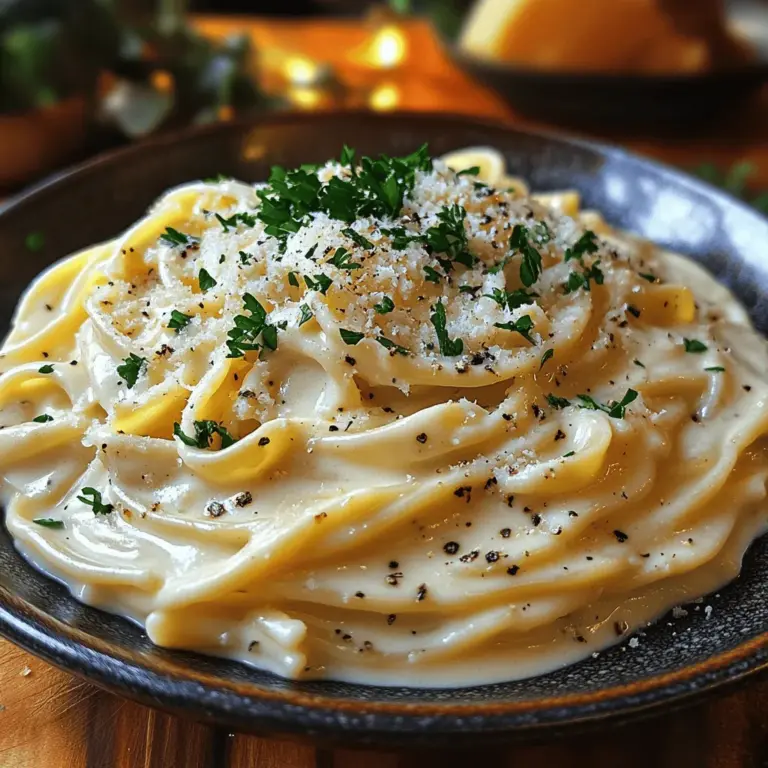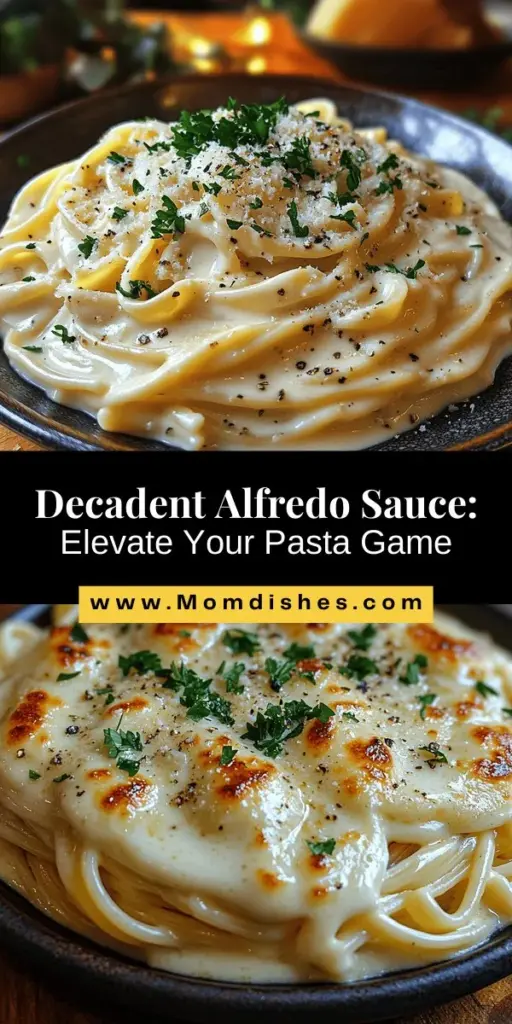Introduction
Alfredo sauce is a classic that has captured the hearts and palates of pasta lovers around the globe. Renowned for its rich, creamy texture and luxurious flavor, this sauce serves as the perfect accompaniment to various pasta dishes, elevating them to gourmet status. Originating in Italy, Alfredo sauce was created in the early 20th century by Alfredo di Lelio, who crafted it for his wife to entice her appetite. Since then, it has grown in popularity, becoming a staple in Italian-American cuisine and appearing on menus worldwide.
The allure of a creamy sauce like Alfredo lies not only in its flavor but also in its versatility. A well-made Alfredo sauce can transform a simple bowl of pasta into an indulgent meal that satisfies both the hunger and the soul. In this article, we will delve into the rich history of Alfredo sauce, explore its essential ingredients, and provide a detailed step-by-step guide to crafting the perfect Decadent Creamy Alfredo Sauce at home.
The Allure of Creamy Alfredo Sauce
Historical Context
The origins of Alfredo sauce can be traced back to the early 1900s in Rome, Italy. Alfredo di Lelio, the creator of this luscious sauce, was a restaurateur who sought to create a dish that would appeal to his wife, who had recently given birth and was struggling with her appetite. The original Alfredo sauce consisted of just three simple ingredients: fettuccine, butter, and Parmesan cheese. This straightforward combination allowed the flavors to shine while providing a creamy coating for the pasta.
As the dish gained fame, it was embraced by American travelers who experienced it in Italy and brought it back to the United States. In the U.S., the sauce evolved to include cream, which further enhanced its richness and made it even more appealing to American tastes. Today, Alfredo sauce is a beloved component of many pasta dishes, including the ever-popular Fettuccine Alfredo, and has inspired numerous variations and adaptations.
Popularity in Modern Cooking
In contemporary cuisine, Alfredo sauce has become synonymous with comfort food. Its creamy texture and comforting flavors evoke a sense of indulgence that many seek after a long day. Whether served over fettuccine, penne, or even as a base for casseroles, Alfredo sauce has proven to be a versatile companion in the kitchen. Moreover, its popularity has led to various interpretations, with chefs and home cooks alike experimenting with different ingredients to create unique variations.
From the addition of sautéed vegetables to proteins like chicken, shrimp, or even lobster, the possibilities for enhancing Alfredo sauce are endless. This adaptability has solidified its place in both Italian and Italian-American culinary traditions, making it a favorite for family dinners, special occasions, and even fine dining experiences.
Emotional Connection
The creamy allure of Alfredo sauce goes beyond mere flavor—it taps into our emotional connections with food. Many people associate creamy sauces with comfort and nostalgia, evoking memories of family gatherings, cozy nights in, and shared meals with loved ones. The indulgent nature of Alfredo sauce allows it to serve as a culinary hug, providing warmth and satisfaction with every bite. This emotional connection is what makes Alfredo sauce a cherished recipe in households around the world.
Essential Ingredients for Perfect Alfredo
To create a Decadent Creamy Alfredo Sauce that is rich, flavorful, and perfectly creamy, it is crucial to understand the role of each ingredient in the recipe. Here’s a breakdown of the essential components:
Unsalted Butter
Butter serves as the foundation of Alfredo sauce, providing richness and flavor. Using unsalted butter is important because it allows for better control over the seasoning of the sauce. By adjusting the salt content yourself, you can achieve the perfect balance of flavors without the risk of the sauce becoming overly salty.
Garlic
Garlic adds depth and fragrance to the sauce, enhancing its overall flavor profile. When sautéed, garlic releases its aromatic oils, infusing the sauce with a subtle yet impactful essence. However, timing is key; overcooking garlic can lead to bitterness, so it should be sautéed just until fragrant.
Heavy Cream
The star of the show, heavy cream is what gives Alfredo sauce its signature creaminess. This ingredient is essential for achieving that luscious texture that coats the pasta beautifully. Heavy cream has a high fat content, which allows it to create a velvety sauce that is both indulgent and satisfying.
Parmesan Cheese
Traditionally, Parmesan cheese is the cheese of choice for Alfredo sauce, lending both flavor and texture. Its nutty and slightly salty profile enhances the sauce, providing a savory depth that pairs perfectly with the cream. Grating fresh Parmesan cheese rather than using pre-grated options is recommended, as it melts more smoothly into the sauce.
Pecorino Romano Cheese
While Parmesan cheese is a staple, adding Pecorino Romano cheese can elevate the sauce with a sharp, tangy flavor. This Italian cheese, made from sheep’s milk, brings a distinct taste that balances well with the creaminess of the sauce. Combining both cheeses creates a well-rounded flavor that is truly irresistible.
Seasoning
The seasoning in Alfredo sauce is crucial for achieving the right balance of flavors. A pinch of salt enhances the overall taste, while freshly cracked black pepper adds a subtle heat. Additionally, a hint of nutmeg can elevate the sauce with a warm, aromatic undertone. These seasonings work together to bring out the best in every ingredient.
Garnish
While not essential to the flavor of the sauce, a sprinkle of fresh parsley serves as a beautiful garnish, adding a pop of color and freshness to the dish. This visual appeal can elevate the presentation of your pasta, making it more inviting and appetizing.
Step-by-Step Guide to Making Decadent Alfredo Sauce
Now that you’re familiar with the essential ingredients, let’s dive into the step-by-step process of making Decadent Creamy Alfredo Sauce. This guide will ensure that you can create a restaurant-quality sauce in the comfort of your own kitchen.
Melting the Butter
Begin by placing a medium-sized saucepan over low to medium heat. Add the unsalted butter, allowing it to melt slowly. This gradual melting ensures that the butter does not brown, which is crucial for maintaining the sauce’s delicate flavor. Stir occasionally to help the butter melt evenly.
Sautéing Garlic
Once the butter is fully melted, it’s time to introduce the minced garlic. Add the garlic to the pan and sauté it for about 30 seconds to 1 minute, or until it becomes fragrant. Be vigilant during this step, as garlic can quickly turn from fragrant to burnt if left unattended. The goal is to infuse the butter with the garlic’s aroma while avoiding any bitterness.
Incorporating Heavy Cream
After the garlic has been sautéed to perfection, it’s time to incorporate the heavy cream. Pour the cream into the butter and garlic mixture, stirring continuously. Bring the mixture to a gentle simmer, allowing it to heat through. This step is essential for achieving the right consistency, as simmering helps the flavors meld together beautifully.
Adding Cheese
Once the cream is heated, gradually add the grated Parmesan and Pecorino Romano cheeses. Stir continuously until the cheeses melt completely and the sauce becomes smooth and creamy. If the sauce is too thick, you can adjust the consistency by adding a splash more of heavy cream or a little pasta cooking water if you have it on hand.
Seasoning to Perfection
Finally, season the sauce with salt, freshly cracked black pepper, and a pinch of nutmeg. Taste as you go to ensure that the flavors are balanced to your liking. The seasoning should enhance the richness of the sauce without overpowering it.
With these initial steps complete, you will have a beautifully creamy Alfredo sauce that is ready to be served over your favorite pasta. The combination of rich flavors and a velvety texture will make this sauce a standout in any meal. As we move forward, we will explore additional tips for achieving the best results and common questions about making Alfredo sauce.
{{image_1}}
Adding Cheese: Techniques for a Lump-Free Sauce
Creating a velvety Alfredo sauce hinges on the incorporation of cheese, specifically Parmesan. To achieve a smooth, lump-free sauce, it’s essential to add the cheese correctly. Begin by grating the cheese yourself rather than using pre-packaged shredded varieties; the anti-caking agents found in packaged cheese can hinder the melting process.
Once your cheese is grated, lower the heat on your sauce before adding the cheese. This helps prevent the cheese from seizing up and ensures it melts evenly. Gradually sprinkle in the grated Parmesan while continuously whisking the sauce. This technique promotes an even incorporation, allowing the cheese to blend seamlessly into the creamy base. If lumps do form, don’t panic! Simply use an immersion blender to smooth out the sauce.
For an extra layer of flavor, consider mixing in different types of cheeses, such as Pecorino Romano or a hint of Gouda. Each cheese brings its unique taste, enhancing the overall richness of your Alfredo sauce.
Adjusting Seasonings: Taste-Testing for the Perfect Balance
Once the cheese is fully melted and incorporated, it’s time to fine-tune the seasoning. Begin with a sprinkle of salt and a dash of freshly ground black pepper. Taste your sauce and adjust accordingly. Remember, the Parmesan cheese already contains salt, so season gradually.
For a bit more complexity, consider adding a pinch of nutmeg—a traditional seasoning in creamy sauces. It enhances the flavor profile without overpowering the dish. Freshly chopped parsley can lend a burst of freshness and color, making your Alfredo sauce not only delicious but visually appealing as well.
Always remember to conduct a final taste test before serving. This crucial step ensures that your sauce meets your flavor expectations, creating a well-rounded dish that everyone will enjoy.
Serving Suggestions: Ideal Pasta Pairings, with Fettuccine Highlighted
While Alfredo sauce pairs beautifully with a variety of pastas, it’s most traditionally served over fettuccine. The wide, flat noodles are perfect for capturing the luscious sauce, ensuring each bite is a delightful experience. To serve, cook your fettuccine in salted boiling water until al dente, then drain and toss it directly in the sauce. This method allows the pasta to absorb some of the flavors, enhancing the overall dish.
Other excellent pasta options include linguine, rigatoni, or even penne for a delightful twist. For those looking to add a bit of texture, consider tossing in some sautéed vegetables like broccoli or peas. They not only add color but also provide a contrast to the creaminess of the sauce.
You might also consider serving your creamy Alfredo sauce over chicken or shrimp, turning a simple pasta dish into a protein-packed meal. Garnish with additional grated cheese and fresh herbs for a restaurant-worthy presentation at home.
Nutritional Insights
Understanding the nutritional content of your creamy Alfredo sauce can help you enjoy it mindfully. A standard serving of Alfredo sauce (about 1/4 cup) contains approximately 200 calories, with a macronutrient breakdown of about 15 grams of fat, 5 grams of carbohydrates, and 6 grams of protein. This rich sauce is high in fat due to the heavy cream and cheese, making it a decadent choice.
That said, moderation is key. Enjoying Alfredo sauce as an occasional indulgence rather than a staple can help you maintain a balanced diet. If you’re looking for alternatives to suit dietary preferences, consider using low-fat cream or a dairy-free substitute, such as cashew cream or coconut cream, to create a lighter version.
For those sensitive to gluten, using gluten-free pasta is an excellent option. Many brands offer delicious alternatives made from rice, quinoa, or chickpeas that pair well with Alfredo sauce, allowing everyone to enjoy this classic dish.
Creative Variations of Alfredo Sauce
While the classic Alfredo sauce is undeniably delicious, there are countless ways to customize it to suit your taste. One approach is to explore different flavor profiles by incorporating fresh herbs. Basil and thyme are excellent choices that enhance the freshness of the sauce. Simply stir in a handful of chopped herbs right before serving.
Incorporating protein is another fantastic way to elevate your Alfredo sauce. Grilled chicken or sautéed shrimp can transform this dish into a hearty meal. Cook the protein separately, then toss it with the pasta and sauce for a satisfying dinner.
Adding vegetables can also complement the creamy texture of Alfredo. Spinach, for example, wilts beautifully into the sauce, providing nutrients and a pop of color. Peas, asparagus, or even sun-dried tomatoes can add flavor and a delightful crunch.
Finally, consider regional adaptations. In some Italian regions, Alfredo sauce is made with a blend of cream, butter, and cheese, while in others, it may be lighter and more herbaceous. Exploring these variations can inspire new culinary creations in your kitchen.
Tips for the Perfect Alfredo Sauce
Creating the perfect Alfredo sauce requires attention to detail. Avoiding common pitfalls is essential for a successful dish. One of the most common mistakes is overheating the sauce after adding the cheese, which can lead to a grainy texture. Always keep the heat low and stir gently to maintain smoothness.
To ensure a rich flavor, use high-quality ingredients. Freshly grated cheese, real butter, and heavy cream will significantly impact the taste of your sauce.
When it comes to storage, Alfredo sauce can be kept in the refrigerator for up to three days in an airtight container. Reheating should be done gently over low heat, adding a splash of milk or cream to restore its creamy texture. Avoid microwaving, as it can cause separation and dryness.
Conclusion
In conclusion, the decadence of creamy Alfredo sauce is an experience cherished by many, and its versatility makes it a staple in both casual and gourmet dining. Whether you’re serving it over fettuccine, experimenting with different proteins or vegetables, or exploring lighter alternatives, this classic sauce opens the door to a world of culinary creativity.
Embrace the richness of Alfredo sauce, and don’t hesitate to make it your own. Whether you enjoy it as a comforting weeknight meal or as a show-stopping dish for special occasions, this creamy delight will continue to hold its place as a beloved favorite in kitchens around the world. So gather your ingredients, channel your inner chef, and savor every bit of this timeless culinary treasure.


